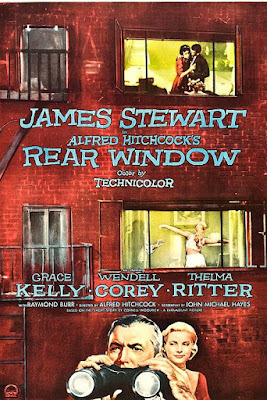Looking Back at “Rear Window”

When I was much younger, I always had trouble with AlfredHitchcock’s 1955 thriller, Rear Window. Set in New York’s Greenwich Village, it’s the story of Jeff, aglobe-trotting photojournalist (James Stewart), who has broken his leg in theline of duty. Stuck in his tiny upstairs flat, with much too much time on hishands, Jeff has nothing to do but spy on his neighbors, through binoculars, inthe apartment building across the way. Critics discuss this film as anexploration of voyeurism, with audience members essentially joining Stewart asPeeping Toms. Some recent feminist scholars have gone further, seeing RearWindow in terms of the notorious “male gaze,” the way movies are designedto reinforce men’s stereotypes about the women they can’t stop watching.
My problem with the film was this: I too had endured abroken tibia. In fact, I’d endured two, from ski accidents a year and ahalf apart. (Yes, I quit skiing thereafter.) So I was sensitive indeed to anyinaccuracies about life in a plaster cast. I could well understand Jeff’srestlessness, and appreciated the detail of him desperately trying relieve the itchyskin inside the cast by cautiously inserting a long-handled backscratcher. But!Why was he stuck in a wheelchair throughout the film? Why wasn’t there a pairof crutches around? Yes, a few weeks ina thigh-to-toe plaster cast can indeed seem like an eternity, but why was Jeffso helpless, and so miserable, when his cast was apparently due to come off amere seven weeks after the accident, thus implying that the break wasn’t allthat drastic? (Try wearing a cast for six months sometime!)
Fortunately, my legs are both whole these days (knockwood!), which frees me to appreciate Hitchcock’s work on this clever and original film. I was not surprised to learnthat it was made entirely on the Paramount Studios back lot, with Jeff’s fixedpoint of view focused almost entirely ona multi-story apartment building that spreads before him like a stage set. It’sa midsummer heatwave, which means (in anera before the widespread advent of air conditioning) that life plays outthrough wide-open windows and on fire escapes. He’s spent so much timeobserving the building’s inhabitants that he’s given some of them nicknames,like Miss Torso (a curvaceous dancer who seems to have few clothes and a lot ofcompany) and Miss Lonelyhearts (who only pretends to have visitors, and appearson the brink of being suicidal).
One neighbor (played by the hulking Raymond Burr) apparentlylikes growing plants in the building’s small flowerbed, but has no use for hisneighbor’s little dog. He also doesn’t seem, from Jeff’s wheelchair-boundperspective, to have the best relationship with his invalid wife. He’s atraveling salesman, so perhaps it’s not odd that he comes and goes at oddhours, carrying a suitcase. But Jeff is quick to cast him as the bad guy in amurder mystery. Is he?
Jeff’s accomplices in trying to solve this mystery that mayor may not exist include a peppery visiting nurse (the always delightful ThelmaRitter) and a gorgeous socialite (Grace Kelly) who’s deeply in love with him.Kelly’s Lisa Fremont makes old-time viewers like me recall what was so greatabout 1950s fashion. Lisa claims she’sready to give up her lavish lifestyle to join Jeff in holy matrimony; he’sskeptical, and perhaps he has reason to be. In the course of this film sheshows her underlying pluck, but are they ready for happily ever after? That’sone mystery that Rear Window never solves.
Beverly in Movieland
- Beverly Gray's profile
- 10 followers



